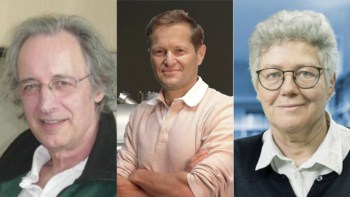
Pulses of laser light can cause any material – including insulators – to develop a relatively large magnetic moment. This effect, which has been demonstrated for the first time by an international team of researchers, shows that laser light can induce quantum behaviour even at room temperature, not just under the extremely cold conditions usually required. While primarily of interest for fundamental science, the technique could also have applications for faster, more efficient magnetic data storage.
In their experiments, Stefano Bonetti of Stockholm University and the Ca’ Foscari University of Venice and colleagues started with a relatively simple idea. By applying laser light that is both circularly polarized – that is, its polarization traces out a corkscrew-like shape as it propagates – and resonant with the frequency of atomic oscillations within a material, they figured they could drive these oscillations in a circular pattern and thus induce a magnetic moment.
The researchers were encouraged in their thinking by theoretical research, which predicted that atoms moving in circular patterns could indeed induce magnetization in almost any material. “Given my expertise in magnetism and my recent investigations into phonon dynamics (lattice vibrations), I believed that my laboratory would be an ideal setting to experiment with this concept,” Bonetti says.
Polarized light source induces large magnetic moments
Before they could begin, the researchers first had to develop a new polarized light source with a frequency in the required terahertz (far-infrared) range. Once the source was ready, they used it to fire short, intense pulses at a sample of strontium titanate (SrTiO3). At room temperature, this material is a paraelectric diamagnet with a cubic perovskite lattice structure. The researchers chose it because some of its atoms vibrate at terahertz frequencies – specifically, at 3 THz with a bandwidth of 0.5 THz.
The team found that these light pulses induced a phenomenon known as dynamic multiferroicity. Multiferroicity occurs when several properties of a material each have their own preferred states. For example, a multiferroic material might have magnetic moments that point in one direction, and electric charge that also shifts in a certain direction. Importantly, the two phenomena are independent of each other.
Though predicted by theory, this phenomenon had never been demonstrated experimentally. Bonetti reports that the experiment also yielded a surprise: the magnetic moments induced in the material were 10 000 times larger than theory predicts.
Magnetic data storage applications
The researchers say their discoveries could find use in magnetic data storage technologies, where there is great interest in novel methods of encoding magnetic information. This is because magnetic domains could be switched by a fast, lower-power electric field, rather than by an electric current (an energy-intensive and relatively slow process) as conventional domains are.

Electric fields control spintronics devices
The team, which also includes scientists from the Nordic Institute of Theoretical Physics (NORDITA) in Sweden; the University of Connecticut and the SLAC National Accelerator Laboratory in the US; the Elettra-Sincrotrone Trieste and the ‘Sapienza’ University of Rome, both in Italy; and the National Institute for Materials Science in Tsukuba, Japan, is now working to better understand the physics of dynamic multiferroicity. “This will be essential for better controlling the effect,” Bonetti tells Physics World. “We also aim to make the effect more persistent, as currently it only occurs while the laser light is active.”
The experiments are described in Nature.


